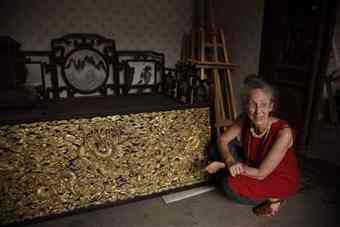Deep in a long-forgotten corner of the Nancy Berliner, curator of Chinese art and culture at the Peabody, reacts near a restored panel at the Forbidden City in Beijing, China. A collection of thrones, large-scale paintings and decor of one of China's most powerful leaders is leaving the country for the first time. In September, the $1.5 million exhibition of items from Chinese emperor Qianlong's period, arrives in Massachusetts for a tour that will show a more intimate side of a country often defined by vastness and control.and up a twisting stairway are four sets of twin doors, shut for more than eight decades. They reveal rare sweeping views to the north, south, east and west above the golden-tiled rooftops of the imperial palace.
 The surrounding walls silence the passing tour groups. On the horizon, modern high-rises are softened by the Beijing smog. The view from this private corner has hardly changed since the Chinese emperor Qianlong designed this courtyard for his retirement more than 200 years ago.
The surrounding walls silence the passing tour groups. On the horizon, modern high-rises are softened by the Beijing smog. The view from this private corner has hardly changed since the Chinese emperor Qianlong designed this courtyard for his retirement more than 200 years ago.
"In my 80s, exhausted from diligent service, I will cultivate myself, rejecting worldly noise," Qianlong wrote of the pavilion, where the floors have been stripped to packed earth and straw as part of a major restoration.
Few people have entered Qianlong's courtyards since China's last emperor was forced out of the Forbidden City in 1924, and it will take more years of work until the public can come inside. The restoration of the pavilion where Qianlong enjoyed the view over the Forbidden City rooftops is set to be finished by sometime in 2012. Bringing the entire complex back to life will take until at least 2019.
But now a collection of thrones, large-scale paintings and decor of one of China's most powerful leaders is leaving the country for the first time. In September, the $1.5 million exhibition arrives in the U.S. for a tour that will show a more intimate side of a country often defined by vastness and control.
"This garden is completely different from the rest of the Forbidden City. The rest is formal, rigid, symbolic. This flows like walking up a mountain flows," said Nancy Berliner, curator of Chinese art at the Peabody Essex Museum in Salem, Massachusetts, where the exhibit of items from the pavilion and courtyards will begin. "You're always finding surprises."
The exhibit will also travel to the Metropolitan Museum of Art in New York and the Milwaukee Art Museum.
The man who expanded China's borders and brought its wealth to new heights was just as ambitious with the art and design of his surroundings. Qianlong, one of the longest-serving Chinese emperors, stepped aside only after six decades.
He is famous for his encounter with the visiting Lord George Macartney, the British emissary who came seeking better trade relations but was refused. "We have never valued ingenious articles, nor do we have the slightest need of your country's manufactures," Qianlong wrote in a smackdown well-known to foreign executives even today.
Yet, "The exhibit reflects Qianlong's fascination with things in the West," said Henry Ng, executive vice president of the World Monuments Fund, a partner in the restoration with China's Palace Museum.
Ng's favorite example is the glass throne, its panes sandwiched between carvings of blossoms and branches. The emperor had the new and fashionable plate glass imported for decoration, but it was mistaken for other materials, such as gray slate, under layers of dust for years during the restoration.
"Then one day I took a tissue and finally wiped it," Berliner said. "It was a wonderful feeling."
Qianlong never moved into the two-acre (0.8-hectare) courtyard complex tucked into the northeastern corner of the Forbidden City. But he used its tiny, winding spaces and gardens for relaxation, and settled on a throne in the high pavilion to practice calligraphy. He'd write bits of poetry and paste them to the walls.
The courtyards' location protected the space from war and upheaval as China struggled to find its political and economic place in recent decades.
When the doors opened again, the Qianlong courtyards were being used as storerooms, with everything covered in 2-inch (5-centimeter) drifts of dust. As work began, the dust was sifted for bits of treasure.
"They'd pick up every single piece and try to fit it back into the original," said Berliner. "One man said they put each piece into little plastic bags. In the end, they had about 35,000 plastic bags."
Officials have searched the country for craftsmen who remember the old arts and techniques to restore the courtyard complex and the exhibit pieces.
In another part of the Forbidden City, woodworker Zhang Shicun smiled over his glasses as he sat low on a bench over a Qianlong panel with a large gold-plated inlay.
"Before him, the emperors' style of the time was rather plain," Zhang said. "This decor, even this groove along the edge of the panel, there was nothing like it. Qianlong loved the details."
Author: Cara Anna | Source: Associated Press [July 30, 2010]















